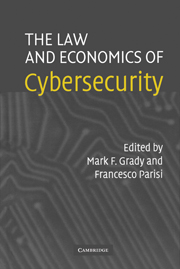Book contents
- Frontmatter
- Contents
- Acknowledgments
- Contributors
- The Law and Economics of Cybersecurity: An Introduction
- PART ONE PROBLEMS
- PART TWO SOLUTIONS
- 5 Network Responses to Network Threats: The Evolution into Private Cybersecurity Associations
- 6 The Dark Side of Private Ordering: The Network/Community Harm of Crime
- 7 Holding Internet Service Providers Accountable
- 8 Global Cyberterrorism, Jurisdiction, and International Organization
- Index
- References
6 - The Dark Side of Private Ordering: The Network/Community Harm of Crime
Published online by Cambridge University Press: 18 August 2009
- Frontmatter
- Contents
- Acknowledgments
- Contributors
- The Law and Economics of Cybersecurity: An Introduction
- PART ONE PROBLEMS
- PART TWO SOLUTIONS
- 5 Network Responses to Network Threats: The Evolution into Private Cybersecurity Associations
- 6 The Dark Side of Private Ordering: The Network/Community Harm of Crime
- 7 Holding Internet Service Providers Accountable
- 8 Global Cyberterrorism, Jurisdiction, and International Organization
- Index
- References
Summary
The common conception of crime, as an act that harms an individual victim, needs rethinking. Instead of examining the impact of crime on the individual victim, this chapter argues that the harm of a criminal act must also be understood with reference to its effect on the community. Once crime is understood in those terms, the dominant conception of criminal policy changes, sometimes in drastic ways. In particular, it will cast some doubt on the desirability of solutions rooted in private ordering and demonstrate the primacy of public enforcement against cybercrime.
Cyberspace presents the easiest vantage point from which to view the community harm of crime. For example, it is commonly argued that many computer crimes, including those that target critical infrastructure, are ones of “curiosity” and result in “no real harm” and that the government should stay out of cyberspace. But even when there is no harm to an individual, acts of cybercrime can undermine the formation and development of networks. For example, the quintessential privacy-violating hacker, who does nothing more than peer into the records of a corporation's server, does not directly damage the corporation's profits. Instead, the upshot of the hacker's activity is more subtle, and likely to take the form of stifling that corporation's network connections in the future. The Internet is the paradigmatic sphere in which the positive advantage of “network effects” is central – that the greater the size of the network, the greater the benefits.
- Type
- Chapter
- Information
- The Law and Economics of Cybersecurity , pp. 193 - 218Publisher: Cambridge University PressPrint publication year: 2005
References
- 2
- Cited by



